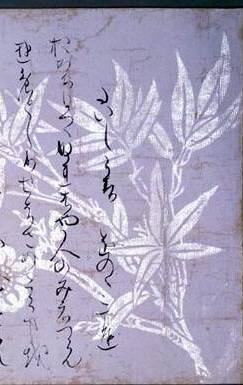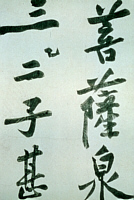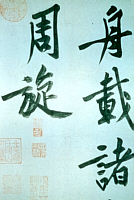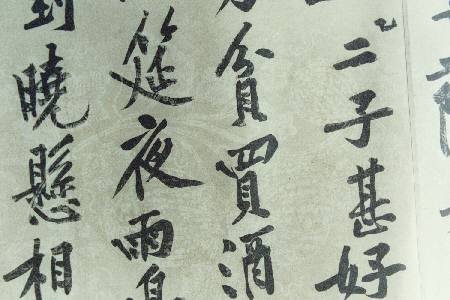Ornamental paper in Sung Dynasty on "Pine Wind Pavillion Poem"
reiji Yamashina, 2003/09/21
Abstracts
Observing ornamental paper in Southen Sung Dynasty
on "Pine Wind Pavillion Poem"
, I think Northen Sung calligraphy was produced among
more dainty circles than I had thought.
Introduction
 Beutiful ornamental papers are often used for
calligraphy in later Heian period Japan(11-12th century).
We sometimes appreciate the ornament than the calligraphy.
This is detail of Hon-AMI-GIRE( a copy of "KOKIN-SYU", 11th century).
This flower printed paper is regarded imported paper from Sung dynasty china.
Beutiful ornamental papers are often used for
calligraphy in later Heian period Japan(11-12th century).
We sometimes appreciate the ornament than the calligraphy.
This is detail of Hon-AMI-GIRE( a copy of "KOKIN-SYU", 11th century).
This flower printed paper is regarded imported paper from Sung dynasty china.
Waxed papers and Quolong Emperor Style papers
in Ching dynasty are colourful, but most chinese calligraphies
are written on white paper.
In Sho-so-In Collection( Nara, Japan) has colorful dyied papers
on which imaginary animals among clouds are drown.
Maybe, it reflects later Tang taste.
Later Heian period ornamental paper was imported from Sung dynasty china,
at least 11th century.
Since a lot of such ornamental papers have survived for 800 years,
the amount imported
was very large. It shoud be internatinal manufacture business at that time.
I felt strange that we couldn't many ornamental papers
among chinese calligraphies survived from Song dynasty.
Many scholars regarded such ornamental papers have survived only in Japan, and
not in China.
However, I've concluded that several ornamental papers survived with chinese
calligraphy from 11th century.
Pine Wind Pavillion Poem Handscroll


This handscroll "Pine Wind Pavillion" is the representative of
Huang Tingjian(1045-1107)
on its quality, history, style, and condition.
In November 1999/11, I found large floral patterns printed on the paper.
On each sheet of white paper, one glove of Vegetables and flowers is
daintily printed with white. They are refined and gorgeous. Usually, you overlook it.
Changing your viewpoint to a sharp angle, you can see these patterns on the paper.
Before then, I appreciated this handscroll two times, but I couldn't
find them.
All Photographes (I saw) can't take these patterns. However, these pictures
show white/light lines and bands in strokes of brashes.
When writing with brush on pattern printed paper, it often happened.
These light lines are traces of patterns.
 Recently I aquired its coulour colotype reproduction. Amazingly, the patterns are clear on it. It is clearer than the real which I found in National Palace Museum in Taipei. Some photograph technique may have it more distinct.
Enlarged IMAGE
ÅE
Recently I aquired its coulour colotype reproduction. Amazingly, the patterns are clear on it. It is clearer than the real which I found in National Palace Museum in Taipei. Some photograph technique may have it more distinct.
Enlarged IMAGE
ÅE
These pattern changed my impression on this masterpiece. I thought it a simple, strong, and stoic. Now I think it refined and gorgious masterpice to gift for
VIP.
Another Examples
Are there another calligraphies on such ornamented paper?
An-chi(1683- ?) described such ornamented papers about some calligraphies in his catalogue(ACE 1743).
Folowing An-chi, in 2000, autumn, I found "Tao-shen Tie" bi Cai-xiang(ACE1012-1067) on an decorated paper
in National Palace Museum in Taipei. The pattern is more modest than "Pine Trees" and likes brocade pattern.
In OSAKA MUNICIPAL MUSEUM, OSAKA, has "Li-Pai Poems" by Su-shi(ACE1036-1101) which is former ABE-collection. Its paper has gooses and leeds picture style decoration. These white lines became very faint so difficult to observe. I had doubted its authenticity for such decorated paper. Descovering "Pine Tree" ornament, I have thrown away such suspicion.
Searching carefully, such examples will become increase.
Conclusion
I think these ornament papers suggest Northen Sung Calligraphy
more dainty and gorgious than I thought.
Return HOME
 Beutiful ornamental papers are often used for
calligraphy in later Heian period Japan(11-12th century).
We sometimes appreciate the ornament than the calligraphy.
This is detail of Hon-AMI-GIRE( a copy of "KOKIN-SYU", 11th century).
This flower printed paper is regarded imported paper from Sung dynasty china.
Beutiful ornamental papers are often used for
calligraphy in later Heian period Japan(11-12th century).
We sometimes appreciate the ornament than the calligraphy.
This is detail of Hon-AMI-GIRE( a copy of "KOKIN-SYU", 11th century).
This flower printed paper is regarded imported paper from Sung dynasty china.


 Recently I aquired its coulour colotype reproduction. Amazingly, the patterns are clear on it. It is clearer than the real which I found in National Palace Museum in Taipei. Some photograph technique may have it more distinct.
Recently I aquired its coulour colotype reproduction. Amazingly, the patterns are clear on it. It is clearer than the real which I found in National Palace Museum in Taipei. Some photograph technique may have it more distinct.